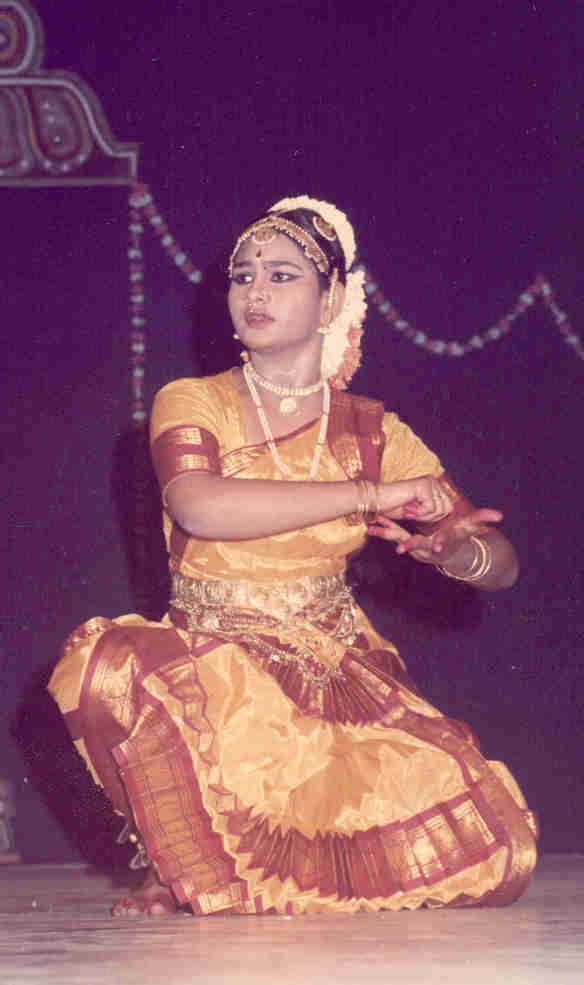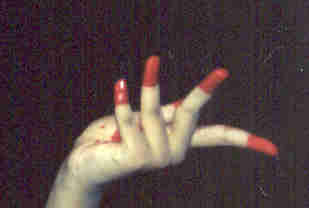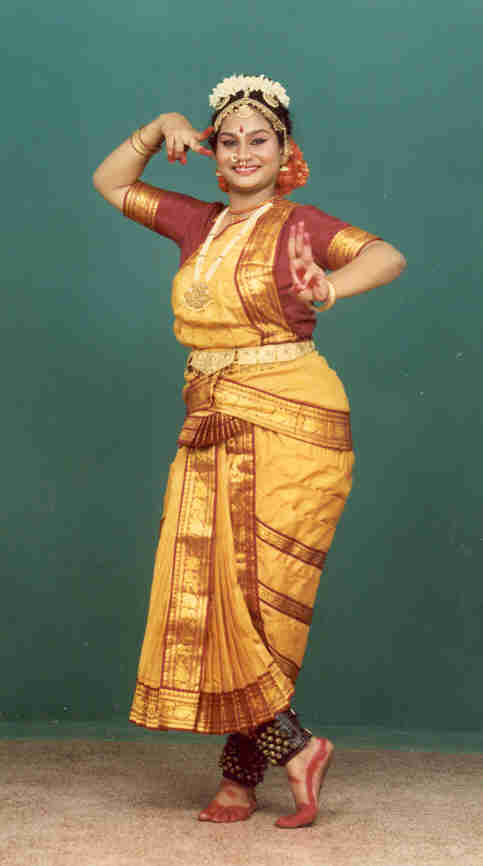Home page | Hand Gestures | Foot Movements| Facial Expressions | Costume |
Among the Fine Arts, Dance or Natya forms the major Branch.It is considered as one of the most popular and highly sacred form of worshipping the Lord.The term Bharathanatyam is believed to have its originfrom "Natyasastra"(book written by Sage Bharatha). One opinion is that the dance invented by Sage Bharatha came to be caled as Bharatha natyam. Another version is that the dance combined in it the aspect of drama,music,stage,color and rhythm,poetry etc.,.Even the term Bharatha is codified by taking the initial syllabels of Bhava , Raga, Tala.
EVOLUTION AND DEVELOPMENT OF BHARATHANATYAM
The origin and antiquity of Bharathanatyam can be traced back to the vedas and to the figure of the dancing girls in Mohen-jo-Daro.The sculptural evidences from the 5th century onwards reveal various changes and development.
History and development of Bharathanatyam
The history of dancing can be categorised under three heads, namely pre-historic, medieval and modern based on its period. The pre-historic period or proto-historic period can be traced to ancient cave paintings,engravings,older civilization etc., The medieval period ranged from 2nd century BC through 9th century A.D.Wherein we get references about dancing from monuments of ancient dynasities, Buddist sthupas,caves of Ellora and temples in various parts of India from Kashmir to Kanyakumari.The temples contain sculptures of dancers of different dance forms. The modern period or the last phase of the period covered from 10th century A.D to the present time. This period witnessed the development and growth of this art to a great extent towards regional, architectural,sculputural, pictorial and musical areas.
During its course of development, Bharathanatyam has refined much, at the same time following the trend and traditions followed in South India from ancient time onwards.The Devadasi Ntittam prevelant in ancient Indian temples can be considered as the precursor of the modern Bharatha natyam. The Devadasis employed in the temples for pleasing Lord, Kings and royal households contributed much towards the perpetuation and preservation of this devine art form. Thr term Devadasi Attom is believed to have evolved from Thevar Adichi-Attom, meaning, the dance of the dasis or the devas or Lord.It must have been presumed that the form was based on the techniques and peculiarities as laid down by Bharatha in his Natyasastra.Afterwards E.Krishna Iyer, another eminent artist popularised it among the public and thus moving the stigma attatched to it.He used to perform in the role of both male and female characters.
The efforts of Rukmini Arundale bore fruit when Kalashetra was established and it became a center of excellence in Bharathanatyam for indians as well as foreigners. By giving systematic and intensive training the art form attained high standard and status.The names of Bala Saraswathi, Kamala Laxman,Mrinalini Sarabhai,are worth mentioning for the immense contribution in this field.They refined this art form to great extent.In addition the effort and experiments done by Smt.Padma Subramaniam, Smt. Chitra Visweswaran, Smt. Sudharani Raghupathi have also helped in improving the standard of performances.
Today Bharathanatyam has attined high status and popularity. Learning of Bharathanatyam has become the status symbol of each and everyone.Within a short period of five decades the art form has reached the masses from the four walls of the temples. It has attained world wide fame and has become a part of internation dance form.
CLASSICAL BHARATHANATYAM RECITAL AND ARANGETRAM
A traditional format, margam (path), of a Bharathanatyam performance, especially important in the graduation performance, or Arangetram, is rather rigidly structured, and reflects the different stages of the dancer's consciousness.
Aranga means raised stage and Etram means climbing in Tamil, one of the south indian languages. It is also called Rangapravesha in Kannada, another south indian language, Ranga meaning Stage and Pravesha meaning Enter. Ideally this should be the first public appearance of the Bharathanatyam artist. This is the occation for the guru to present his/her deciple to the public. This is the testing time for both the guru and the shishya(deciple) as the guru's knowledge and the deciple's talent both are judged by the public. Hence, the guru will decide when the deciple is ready for public graduation. Usually, at least 10-12 years of training is necessary before the Bharathanatyam dancer is ready for Arangetram.
Arangetram was known as Gejjepooje in the old Mysore district, meaning worshiping the jingles in Kannada. For a Bharathanatyam dancer, jingles are considered divine. Formerly, deciples were not allowed to wear jingles till their first public performance when they consecrated the jingles, wore them and then performed.
Accompaniments play a major role in the making of a memorable dance performance.Basic accompaniments comprise a singer, a mridangam player, a violin player and the Natuvanga. Veena, flute and other instruments are optional. These people sit in the corner of a stage or in a place in front of the stage which will be in a lower level than that of the stage. The Bharathanatyam artist wears lot of jewellery, make-up and a specially stitched dress. Jingles are a must. Usually duration of an arangetram will be 2 1/2 - 3 hours. To perform for such long hours one must have good stamina and concentration. This time is divided into two parts.
In the first half the Bharathanatyam artists generally performs
- Pushpanjali
- Alaripu
- Jatiswara
- Shabdam
- Varnam
In the second half:
- Padam
- Ashtapadi or Devaranama
- Tillana
- Mangala
Pushpanjali
This is an item where the Bharathanatyam dancer salutes to god, guru and the audience. This item is a warm-up item where
the artist prepares the body for the next hours of vigorous performance.
Alaripu ("budding flower")
Includes pure nritta. The movements are performed for syllables set for a beat
(Tala). The complexity of the movements gradually increase, as the dancer's attention
focusses more and more.. The steps are so formed that it looks like a bud blooming
into a flower. This is also a warm-up piece to prepare the body for the next hours
of Bharathanatyam performance. Even though there is no obvious message communicated
here, this can also be considered as an item where the artist salutes god, guru
and the audience.
Jatiswaram
This is also an item where the movements will not convey any meaning or theme.
Here the steps are more complex than the previous items. The composition can have
amazing postures and teermanas or muktayas (ending of a jati). This is a musical
composition set to a raga unlike alaripu which has only syllables.
Shabdam
This is a dance item with both nritta and abinaya. Usually the theme of the lyrics
will be devotional like praising lord Krishna, depicting Krishna's childhood,
praising a king etc.The movements here are leisurely. In the Sabdam, emotions
are withheld at the beginning; thereafter, when the dancer has clarified herself,
they are released in a measured and disciplined manner. It is after, mastering
this discipline that she dances the Varnam which is a living river that holds
together movement and interpretation.
Varnam
This is the item where the Bharathanatyam dancers are tested for their capacity
to perform both abinaya and nritta. This can be treated as a benchmark to judge
the artist's talent.The item will contain many complex steps and will have lot
of room for expressions also. To perform this item one should have lot of stamina
and concentration. The lyrics can be devotional, praising a king etc. Varna can
also have shrigara rasa as its theme.
Padam
In this dance item the dancer's abhinaya is put into test. It narrates expression
of divine love or pangs of seperation in love. The tempo is slow and the performance
is based on a specific mood of love.Padams will have Nayaka (Hero, Supreme
lover, Divine Lord)and Nayika (Heroine, the yearning soul).
Heroine will talk to her friend (sakhi) and narrate her feelings towards
her hero. The Bharathanatyam lyrics can be about how the hero has betrayed,
how he has delayed his arrival, how she is angry with her beloved hero etc.
Ashtapadi
These are poet Jayadeva's Sanskrit compositions called Geetagovinda,
an extremely romantic composition. It describes the love of Krishna and Radha
in twelve cantos containing 24 songs. The songs are sung by Krishna or Radha or
by Radha's maid. Each Canto is named differently considering Krishna's status
of mind.
- Saamodadamodara - Joyful Krishna
- Aakleshakeshava - Careless Krishna
- Mugdhamadhusoodhana - Bewildered
Krishna
- Snigdhamadhusoodhana -
Tender Krishna
- Saakankshapundareekaksha - Longing Krishna
- Kuntavaikunta - Indolent Krishna
- Naagaranaaraayana - Cunning Krishna
- Vilakshalakshmeepatihi - Abashed Krishna
- Mandamukunda - Languishing Krishna
- Chaturachaturbhuja - Intelligent Krishna
- Saanandadamodara - Blissful Krishna
- Supreetapeetambara - Ecstatic Krishna
Expressions are given
foremost importance while performing these poems. Needs lot of grace. The Bharathanatyam artist should be mature enough to understand the lyrics and the situation to show
the rasas.
Devaranama
This item is a devotional piece where the lyrics are in praise of god, describing
the god etc. This is a pure abhinaya item with almost no emphasis on nritta. These
songs are the Bharathanatyam compositions of great mystics like Purandharadaasa,
Kanakadaasa, Vijayadaasa, Vyasaraaja to name a few. The Bharathanatyam compositions are popularly known as Daasa Sahitya. It is a devotional
literatures written in simple language understood by common man. It has made remarkable
contribution to the spiritual and cultural upliftment of people by preaching phylosophy
of Love, Devotion and Peaceful Co-Existance. If you are looking for some compositions, here they are.
Tillana
This is usually the last item in any Bharathanatyam performance. Tillana is full of complicated movements and postures. This will
also have complicated Muktayas or Sholkattu, ending of any step
or aduvu. This is mainly a nritta piece which might have a charana, a meaningfull
lyrics for which abinaya is shown.
Mangalam
Meaning ending the performance. Here the Bharathanatyam
artist will again salute god, guru and the audience for making the performance
a success.
A Bharathanatyam recital resembles the structure of
a Hindu temple: first, one passes through the gopuram (outer gate) of alarippu,
then one crosses the ardhamandapam (midway hall) of jatiswaram, next the mandapam
(great hall of worship) of sabdam and enter the heart of the temple in the varnam.
For more infomation
For More information





